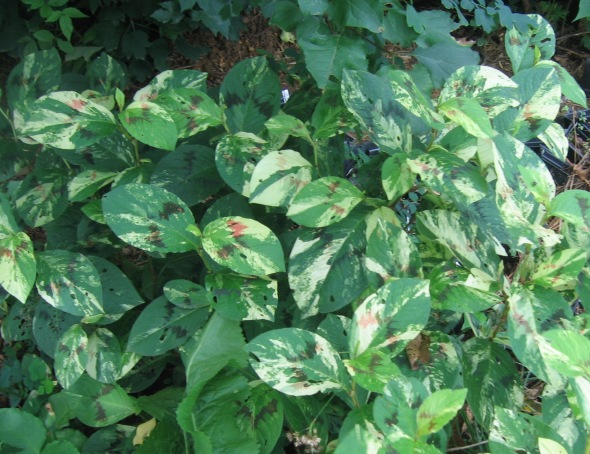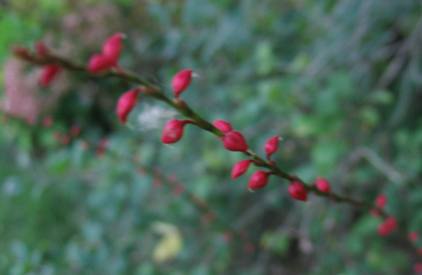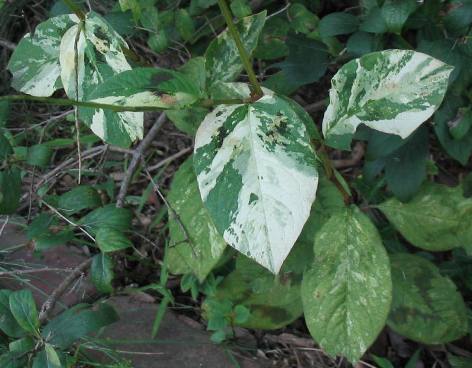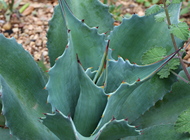 |
Persicaria virginiana 'Painter's palette' |
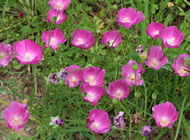 |
| Synonym(s) |
Tovara virginiana, Polygonum virginianum |
| Common name |
painter's palette |
| Family |
polygonaceae |
| Life cycle |
perennial (Z4-8) |
| Flowers |
tiny red beads (late summer) |
| Size |
18-24" |
| Light |
sun-part shade |
| Cultural notes |
ordinary garden soil, grows best when not too dry |
From seed  |
give 4-6 weeks cold, then germinate at room temperature
detailed seed-starting info below
|
| Seed ripens | early November |
Primarily a foliage plant, grown for its boldly variegated leaves. Although a member of the weedy polygonum family, this one is well worth growing. It seeds around a bit, but not enough to be a nuisance, and brightens up the scene in unexpected places. The tiny red flowers appear in late summer and are easy to miss (but quite interesting up close).
|
|
We left this plant behind in our Pennsylvania garden (and wish it well); we don't grow it in Houston. Seed for this plant is included on my seed trade list About my plant portraits
PlantLinks to other web pages about Persicaria virginiana 'Painter's palette'
Visitors to this page have left the following comments| Donato | Aug 02, 2005 | Is the painters palette an American native plant? As its name might apply, is it from the VA region?
I've had it for years, love it and never knew what to call it. I have an entire walkway covered by it on both sides. Its beautiful!
Great site! Thanks for the plant id!
Yes, it is a US native. According to this USDA site, it is distributed across just about all of the Eastern US. |
| Sue | Apr 14, 2006 | A friend and I both fell in love with the painter's palette last summer and bought ones for her garden and for mine. Our question now that spring has come is how to prune it .... right back down to the ground, or does new growth occur on existing branches? It's a gorgeous plant and I'm so happy to find a page like yours with information on it, and a page that's so well laid out and informational. Thank you!
It may depend on your zone. In my garden, the plant dies back completely to the roots, or a few low-growing rosette leaves, so I prune off the top growth either in fall or early spring, before active growth starts up again. |
| Sue | Apr 15, 2006 | Thanks so much for answering so quickly, Rob! We're Zone 5a here (north of Toronto, in Ontario), and my painter's palette looks intact from last year, although the stems are all a shiny reddish brown now, not green. I haven't seen any growth on it at all, and have been debating whether to cut back to just above ground level or wait and see what happens. |
| MartyAnne | Sep 18, 2008 | I took an unknown plant that I've had for about four years to a reputable nursery and completely stumped them. It is the Painter's palette which I found by googling variegated+leaves+"tiny+red+flowers" and it was on the second page. It is doing well in a little pot under a shade tree in hot, dry Sacramento. Thanks for the picture and information |
| Barbara | Oct 26, 2009 | I just collected some seeds from the park (NYC)where this plant grows in the midst of the unvariegated form. Do they come true to seed? Have you tried winter-sowing?
Wintersowing should work just fine. I only grow the variegated form, and all the offspring comes true. But with mixed parentages, I think you'll get mixed offspring. Just weed out the ones with plain foliage. |
| Diana | May 06, 2010 | I love this plant! I bought it many years ago at a now-defunct big box store (Frank's Nursery & Crafts) where they had no idea what it was. I do absolutely nothing to care for it, except to dig up volunteers from elsewhere in the bed and carefully replant. I have given pieces to other gardeners (just dig up a clump with roots & soil) and it thrives for everyone. |
| Bill | Jun 15, 2010 | I have grown this plant in the suburban Detroit area, Zone 5, for over ten years, and find it to be virtually carefree to grow. It tolerates both sun and shade very well. If it gets a bit too tall for the area it is planted in, it can be lopped off with garden shears without damage and still looks good. It self seeds prolifically and provides give away plants on a regular basis. I find it best to cut it to the ground each fall, and it comes back stronger in the spring. It is a very easy plant to grow, and receives complements on a regular basis. |
| Sallie | Jun 25, 2011 | Thanks for the great information.
We have painter's palette taking over our entire garden. Although we have read that it is hard to grow in some areas it seems to spread uncontrollably in our garden. We are worried that it will spread into open space land around our property. We have been struggling to keep up with it and spend countless hours pulling it up. This year the strategy is to get to it before it seeds. Do you know if there is any specific herbicide or poison which will selectively kill it (without harming other plants) and is not a negative to the environment or pets and wildlife?
Sorry to hear this misbehaves for you. In our garden, it's an enthusiastic contributor (which is nice, because it looks so wonderful when massed), but not difficult to keep within bounds. Unfortunately, I don't know of a specific herbicide. |
| Anne | Oct 15, 2011 | I am so excited to find this information on Painter's Palette! I visited the breeder of my cocker puppy last year, and she pulled up a plant when I expressed interest. Sadly, she died recently of cancer, so this plant means more than ever to me. I'm in zone 5 (PA) and it has not yet spread although I would like it to. Do I need to wait awhile?
This plant will get larger year by year as it matures, but it will not spread to cover more ground by roots; the increase in patch size will come from seeding. If conditions are favorable, you should see seedlings emerge in spring around the area where your plant bloomed the previous year. |
| Gaynor | Jan 31, 2013 | How do I get rid of painter's pallette, persicaria virginiana? It is very invasive and I CANNOT stop it. Help!
While I've found other polygonum/persicaria species to be quite difficult to control, this one has not been a problem - it spreads prolifically in the area immediately surrounding the mother plants if it is allowed to bloom - but it blooms so late in the season that it should be easy to remove plants before they bloom. They do not spread by roots, so getting them all before they set seed should be sufficient to eradicate them, if you wish to do so. You may need to pull more volunteers for a few years as remaining seeds decide to sprout. |
| Jane | Jun 30, 2013 | I too have this plant running wild in my garden. It seems to grow on runners, not spread from seeds. We keep pulling it out. I like it too much to just pull it all out so I potted some to keep it contained.
I'm sure ours spreads only by seed. If I were concerned about its spread, I would remove the flowering stalks (which are only a minor part of its charm, in my book). |
| Kathy | Sep 14, 2013 | I love my Painter's Pallet & I would love an entire yard of it! beats mowing! It is beautiful & I am into naturalizing, as I don't want my acreage to look like a nursery. It looks wonderful along a flagstone path. How tolerant is this plant, I had it planted out in the woods & therefore it didn't get much sun, when I planted it up near the house with the western sun exposure, it just exploded in size. Can I split the root system without harming the plant, as I would like to propagate this plant out in the open. We live in zone 5 & have harsh winters.
In my experience, it doesn't appreciate root disturbance, so I don't know if division is the way to go. On the other hand, it seeds around generously, and the young seedlings can be easily transplanted in early spring. |
| Kate | Oct 12, 2013 | I have done much reading on Painter's Palette. It has been classified and reclassified. While it is now Persicaria virginiana, it has also been known as Virginia knotweed, Jumpseed, Persicaria filiformis, Tovara virginiana. Those of you who are having problems with extreme invasiveness may not have P. virginiana but a similar plant in the knotweed family (Polygonum). To be P. virginiana, I believe it must have varigation and red inflourencences. In other words, buyer beware. I have put plants in my garden, then after some reading, decided I had invited a monster into the house, and tore it up. |
| Dorothy | Jun 01, 2015 | This plant just came up this spring as a volunteer in my south facing sunny garden. The leaves are solid green with the burgundy/chocolate markings, but no white variegation. Some sources say to plant in a sunny garden, and others in a shady garden. I would like to encourage its growth, but should I leave it where it is, or move to my backyard shady garden? I live in zone 5, Northeast Ohio. Thanks!
While these plants will seed around, and sometimes pop up in sunnier areas, they really thrive in the shadier spaces, so a move might be warranted. Move it with a clump of soil around the roots: they don't particularly care to be transplanted, in my experience. The white variegation sometimes doesn't show until later in the season, but there are also unvariegated forms; you should know in another month or so which one you have. |
| bill | Sep 05, 2015 | I have a good supply of painters palette and want to transfer to another property by taking the seeds. When should I clip the seed stems? Before the flowers open or after? Thanks for the help.
Wait till the flowers are done and the seed husks turn tan/brown. At that stage, they pop off the stems easily. In my garden, that doesn't happen till much later in the season (late October/early November). |
| Sharon pizzuto | Sep 27, 2015 | Bought this plant at a farmers market two years ago, they weren't sure of its name. I was finally able to recognize it from your picture on this website. I now have four more in various areas of the garden,and think it is a beautiful addition. Grows better for me in shady areas thank you for a very good picture for identification. |
| Harlan | Jul 20, 2016 | I bought this plant at a garage sale from a person who apparently had too many and was offering them to others. I planted it and it was one of my favorites. This spring the parent plant did not come back and I saw no indication that it had seeded. However, looking around a 4 yard radius of the original plant in late June I saw multiple seedling of the plant that were 1" to 2" high. One was about 4 inches tall and was about 4 yards from the original. Now it is midJuly and the smaller ones are maybe 2 inches tall and the larger one is a little taller, but I see no indication that they are growing quickly in shady garden in which hostas and other shade-lovers grow.
Has anyone else noticed that these are very slow-growing plants> I'm afraid that they won't mature by the time fall arrives.
I agree it is unlikely that they will mature to flower and set seed by end of season. However, these plants are quite hardy, so perhaps your new crop will survive winter to return to a more vigorous second year in your garden. Good luck! |
| Donna Alber | Feb 12, 2018 | I took several cutting off a plant from a friend. Stuck them in water over the winter in the house. All rooted. I recognized it's heritage from the great weed in Nebraska. They called Ladys's Thumb. I ate the seeds sometimes. Ours here in the PNW, are pretty small and weedy. Never ever saw this or any of it's plainer varieties in the 8 years we lived in N. Virginia. My chosen rooted start was potted up in the spring, 2017, and grew beautifully, bloomed in fall. Gorgeous. I came here to find out how to prune. So thanks for all of help and comments. |
| Dana Holmgrain | Aug 06, 2019 | im alittle confused about persicaria virginia.You Said to oone of the visitors to your website that acording to the USDA Persicria virginia is native to the eastern part of the USA. I looked at their web site and could only find polygonum virginianum and it apeared to have white flowers and diferent shaped leaves with less coloration. I have the one in your picture and was wondering if you could clrify this a little more.
Persicaria and polygonum are a hopelessly confused bunch that botanists haven't historically agreed upon. At this time, Persicaria virginiana appears to be the preferred version, with Polygonum virginianum listed as a synonym. The plain species isn't as boldly colored – 'Painter's Palette' is a selected variety (that comes true from seed). |
| Eva | May 27, 2020 | I wonder if some of the gardeners complaining about invasiveness actually have Houttuynia cordata “Chameleon� When I bought my painter’s palette at a native plant sale, the vendor took pains to assure me that it was not the dreaded chameleon plant. |
| Mike | Apr 12, 2021 | I am told that Persicaria filiformis, aka Persicaria virginianum var filiformis, is imported from Japan and is virtually identical in appearance. Do you know about this and, if so, how to distinguish the native and non-native varieties? |
| Sue, Canberra Australia. | Apr 15, 2021 | Friend gave me this plant, variegated leaves and long spikes with tiny red flowers. Lovely. Will this spread and become a rampant pest in my garden? |
| Mindy | Sep 12, 2021 | Spreads like crazy...if you have pets, the seeds will get on them and spread that way. I love this plant but don't get one started if you aren't prepared for spread. It is invasive no matter what some sites are saying. I have it in places I would never think I would have them (cracks in sidewalks, joints in patio pour, etc.). It is a lovely plant but when I have friends and family ask me for seeds, I tell them not to blame me when things get out of control. LOL. |
| Lori | Sep 15, 2021 | I am looking at your comments about seed starting the Painter's Palette (2001 - 2004). I am new at this so do not understand when you say "cold treatment appears to be necessary". I live in eastern MA, does that mean I leave the seeds out until November? It is now the middle of September and the seeds are red. Thank you. |
| Pierre | Apr 29, 2022 | Hi! I bought three plants last summer. It's spring and seems they have died over the winter. I'm in a z4 and it's almost May; should I worry?
Yeah, they should have been up by now - it least, they would have been in Pennsylvania, which is probably not so far ahead. |
- Seed from trade#1. Baggy, 70F (4wks); cold (5 wks); 70F (no germination)
Seed from trade#2. Baggy, cold (5 wks); 70F (65%G, 4-9d
- Seed from trade#2. Baggy, cold (3 wks); 70F (14%G, 7-14d).
- Seed from '02 garden. Baggy, cold (5 wks); 70F (10%G, 8d)
- >Seed from '03 garden. Baggy, cold (5 wks); 65F (28%G, 6-12d).
Cold treatment appears to be necessary, and germination is rather low - sow several times the number of plants required. Seedlings are very cold-sensitive - don't set out until after all danger of frost.
I welcome comments about my web pages; feel free to use the form below to
leave feedback about this particular page. For the benefit of other visitors
to these pages, I will list any relevant comments you leave, and if
appropriate, I will update my page to correct mis-information. Faced with an
ever-increasing onslaught of spam, I'm forced to discard any comments including
html markups. Please submit your comment as plain text. If you have a
comment about the website as a whole, please leave it in my
guestbook. If you
have a question that needs a personal response, please
e-mail me.
Last modified:
February 01, 2009
Contact me
|


